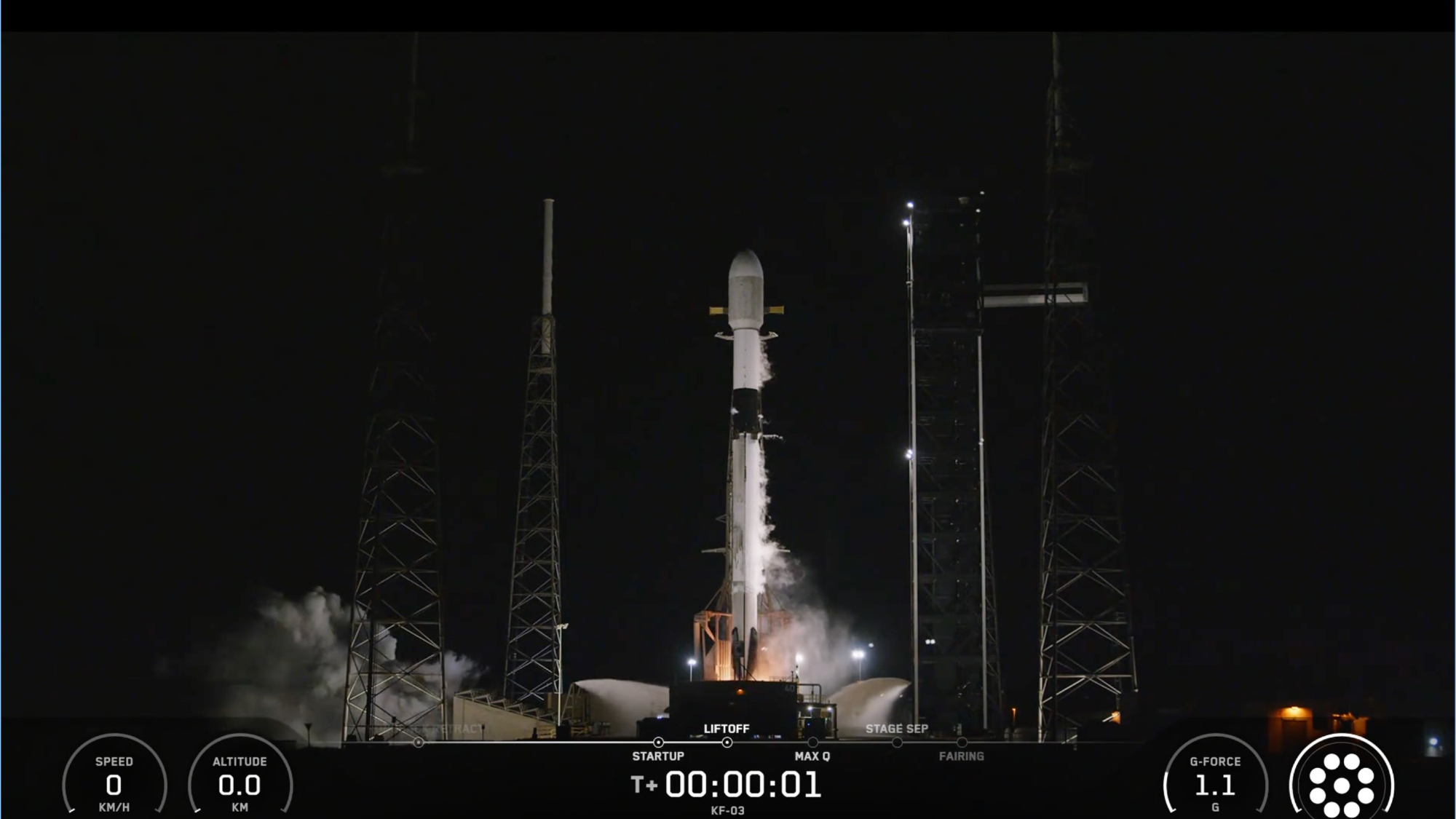SpaceX launches 24 of Amazon's Project Kuiper internet satellites to orbit (video)
Liftoff occurred at 9:58 p.m. ET on Monday (Oct. 13).
Amazon's Project Kuiper broadband megaconstellation continues to grow.
Twenty-four more Project Kuiper satellites took flight on Monday (Oct. 13), lifting off from Florida's Cape Canaveral Space Force Station atop a SpaceX Falcon 9 rocket at 9:58 p.m. EDT (0158 GMT on Oct. 14). Launch was originally scheduled for Thursday evening (Oct. 9), but SpaceX pushed that back by four days.
It was SpaceX's third Project Kuiper launch and the sixth overall dedicated to building out the nascent network, which will eventually consist of about 3,200 satellites in low Earth orbit (LEO). With today's launch, 153 of them have now reached the final frontier.

The rest will be lofted on more than 70 additional launches conducted by a variety of rockets — the Falcon 9, Arianespace's Ariane 6, Blue Origin's New Glenn and United Launch Alliance's Atlas V and Vulcan Centaur.
If all goes to plan today, the 24 Kuiper craft will be deployed by the Falcon 9's upper stage at an altitude of 289 miles (465 kilometers), over a 7.5-minute stretch that begins 56.5 minutes after liftoff.
"From there, we perform initial satellite health checks and prepare to raise the satellites to their assigned altitude of 392 miles (630 km), where they will be fully commissioned as part of our operational satellite constellation," Amazon representatives wrote in a mission description.
As on virtually every SpaceX launch, there was action in the downward direction today as well: The Falcon 9's first stage touched down in the Atlantic Ocean on the SpaceX droneship "Just Read the Instructions" a little over eight minutes after liftoff.
Breaking space news, the latest updates on rocket launches, skywatching events and more!
It was the second launch and landing for this particular booster, according to SpaceX. The vehicle first flew Aug. 11 on another Project Kuiper launch, which happened to be SpaceX's 100th mission of the year.
Project Kuiper isn't the only broadband megaconstellation under construction in LEO. SpaceX's Starlink network already features more than 8,500 operational spacecraft, and it's growing all the time; SpaceX has launched more than 90 Starlink missions so far this year alone.
And China is building two megaconstellations of its own, Guowang ("National Network") and Qianfan ("Thousand Sails"), each of which will host about 13,000 satellites, if all goes to plan.
The Project Kuiper liftoff was the second of the day for SpaceX. On Monday evening, the company launched the 11th test flight of its Starship megarocket, sending the giant vehicle up from its Starbase site in South Texas. The mission was a complete success, according to SpaceX.
Editor's note: This story was updated at 3:10 p.m. ET on Oct. 9 with the new launch date of Oct. 11, then again at 3:15 p.m. ET on Oct. 11 with the new target date of Oct. 12, and again at 12:50 p.m. ET on Oct. 12 with the new target date of Oct. 13. It was updated again at 10:08 p.m. ET on Oct. 13 with news of successful liftoff and rocket landing.

Michael Wall is a Senior Space Writer with Space.com and joined the team in 2010. He primarily covers exoplanets, spaceflight and military space, but has been known to dabble in the space art beat. His book about the search for alien life, "Out There," was published on Nov. 13, 2018. Before becoming a science writer, Michael worked as a herpetologist and wildlife biologist. He has a Ph.D. in evolutionary biology from the University of Sydney, Australia, a bachelor's degree from the University of Arizona, and a graduate certificate in science writing from the University of California, Santa Cruz. To find out what his latest project is, you can follow Michael on Twitter.
You must confirm your public display name before commenting
Please logout and then login again, you will then be prompted to enter your display name.
